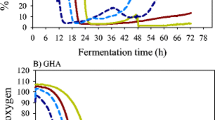Abstract
Rice and oat flours were analyzed as media for the production of conidia by M. anisopliae var. lepidiotum. The presence of peptone increased conidia yield regardless of the substrate used; however, the highest yield was achieved on oat flour media. The effect of oxygen on conidia production using oat-peptone medium was also studied at two levels: Normal atmosphere (21% O2) and Oxygen-rich pulses (26% O2). Maximum conidia production (4.25 × 107 conidia cm−2) was achieved using 26% O2 pulses after 156 h of culture, which was higher than 100% relative to conidial levels under normal atmosphere. Conidia yield per gram of biomass was 2.6 times higher with 26% O2 (1.12 × 107 conidia mg−1). Conidia quality parameters, such as germination and hydrophobicity, did not show significant differences (P < 0.05) between those treatments. Bioassays parameters, using Tenebrio molitor adults, were analyzed for conidia obtained in both atmospheres and data were fitted to an exponential model. The specific mortality rates were 2.22 and 1.26 days−1, whereas lethal times for 50% mortality were 3.90 and 4.31 days, for 26% O2 pulses and 21% O2 atmosphere, respectively. These results are relevant for production processes since an oxygen increase allowed superior levels of conidia by M. anisopliae without altering quality parameters and virulence toward Tenebrio molitor adults.



Similar content being viewed by others
References
Sun MH, Liu XZ. Carbon requirements of some nematophagous, entomopathogenic and mycoparasitic Hyphomycetes as fungal biocontrol agents. Mycopathologia. 2006;161:295–305.
Arzumanov T, Jenkins N, Roussos S. Effect of aeration and substrate moisture content on sporulation of Metarhizium anisopliae var. acridum. Process Biochem. 2005;40:1037–42.
Prakash BGVS, Padmaja V, Kiran SRR. Statistical optimization of process variables for the large-scale production of Metarhizium anisopliae conidiospores in solid- state fermentation. Bioresour Technol. 2008;99:1530–7.
Sun J, Fuxa JR, Henderson G. Sporulation of Metarhizium anisopliae and Beauveria bassiana on Coptotermes formosanus and in vitro. J Invertebr Pathol. 2002;81:78–85.
Kamp AM, Bidochka MJ. Conidium production by insect pathogenic fungi on commercial available agars. Lett Appl Microbiol. 2002;35:74–7.
Shah FA, Wang CS, Butt TM. Nutrition influence growth and virulence of the insect-pathogenic fungus Metarhizium anisopliae. FEMS Microbiol Lett. 2005;251:259–66.
Rangel DEN, Anderson AJ, Roberts DW. Growth of Metarhizium anisopliae on non-preferred carbon sources yields conidia with increased UV-B tolerance. J Invertebr Pathol. 2006;93:127–34.
Issaly N, Chauveau H, Aglevor F, Fargues J, Durand A. Influence of nutrient, pH and dissolved oxygen on the production of Metarhizium flavoviride Mf189 blastospores in submerged batch culture. Process Biochem. 2005;40:1425–31.
Driver F, Milner RJ, Trueman JWH. A taxonomic revision of Metarhizium based on a phylogenetic analysis of rDNA sequence data. Mycol Res. 2000;104:134–50.
Angelova BM, Pashova BS, Spasova KB, Vassilev VS, Slokoska SL. Oxidative stress response of filamentous fungi induced by hydrogen peroxide and paraquat. Mycol Res. 2005;109:150–8.
Belozerskaya TA, Gessler NN. Oxidative stress and differentiation in Neurospora crassa. Microbiology. 2006;75:427–31.
Hansberg W, Aguirre J. Hyperoxidant states cause microbial cell differentiation by cell isolation from dioxygen. J Theor Biol. 1990;142:287–93.
Toledo I, Rangel P, Hansberg W. Redox imbalance at the start of each morphogenetic step of Neurospora crassa conidiation. Arch Biochem Biophys. 1995;319:519–24.
Sowjanya Sree K, Padmaja V. Oxidative stress induced by destruxin from Metarhizium anisopliae (Metch.) involves changes in glutathione and ascorbate metabolism and instigates ultrastructural changes in the salivary glands of Spodoptera litura (Fab.) larvae. Toxicon. 2008;51:1140–50.
Wang C, Duan Z, St Leger RJ. MOS1 osmosensor of Metarhizium anisopliae is required for adaptation to insect hemolymph. Eukaryot Cell. 2008;7:302–9.
León-Santiesteban H, Bernal R, Fernández FJ, Tomasini A. Tyrosinase and peroxidase production by Rhizopus oryzae strain ENHE obtained from pentachlorophenol-contaminated soil. J Chem Technol Biotechnol. 2008;83:1394–400.
Bischoff JF, Rehner SA, Humber RA. A multilocus phylogeny of the Metarhizium anisopliae lineage. Mycologia. 2009;101:512–30.
Samuels KDZ, Heale JB, Llewellyn M. Characteristics relating to the pathogenicity of Metarhizium anisopliae toward Nilaparvata lugens. J Invertebr Pathol. 1989;53:25–31.
Ibrahim L, Butt MT, Jenkinson P. Effect of artificial culture media on germination, growth, virulence and surface properties of the entomopathogenic hyphomycete Metarhizium anisopliae. Mycol Res. 2002;106:705–15.
Shah AF, Allen N, Wright JC, Butt MT. Repeated in vitro subculturing alters spore surface properties and virulence of Metarhizium anisopliae. FEMS Microbiol Lett. 2007;276:60–6.
Rodríguez-Gómez D, Loera O, Saucedo-Castañeda G, Viniegra-González G. Substrate influence on physiology and virulence of Beauveria bassiana acting on larvae and adults of Tenebrio molitor. World J Microbiol Biotechnol. 2009;25:513–8.
Michán S, Lledas F, Baldwin JD, Natvig DO, Hansberg W. Regulation and oxidation of the large monofunctional catalases. Free Radical Bio Med. 2002;33:521–32.
Pascual S, De Cal A, Magan N, Melgarejo P. Surface hydrophobicity, viability and efficacy in biological control of Penicillium oxalicum spores produced in aerial and submerged culture. J Appl Microbiol. 2000;89:847–57.
Acknowledgments
Tlecuitl-Beristain, S. (Reg. No. 117823) thanks the Mexican National Council for Science and Technology (CONACyT) for the scholarship. This study was financed by the Universidad Autónoma Metropolitana- Iztapalapa and Red PROMEP-Mexico. Authors wish to thank Dr. FJ. Fernández for his technical help in the molecular identification of the strain.
Author information
Authors and Affiliations
Corresponding author
Rights and permissions
About this article
Cite this article
Tlecuitl-Beristain, S., Viniegra-González, G., Díaz-Godínez, G. et al. Medium Selection and Effect of Higher Oxygen Concentration Pulses on Metarhizium anisopliae var. lepidiotum Conidial Production and Quality. Mycopathologia 169, 387–394 (2010). https://doi.org/10.1007/s11046-009-9268-7
Received:
Accepted:
Published:
Issue Date:
DOI: https://doi.org/10.1007/s11046-009-9268-7




